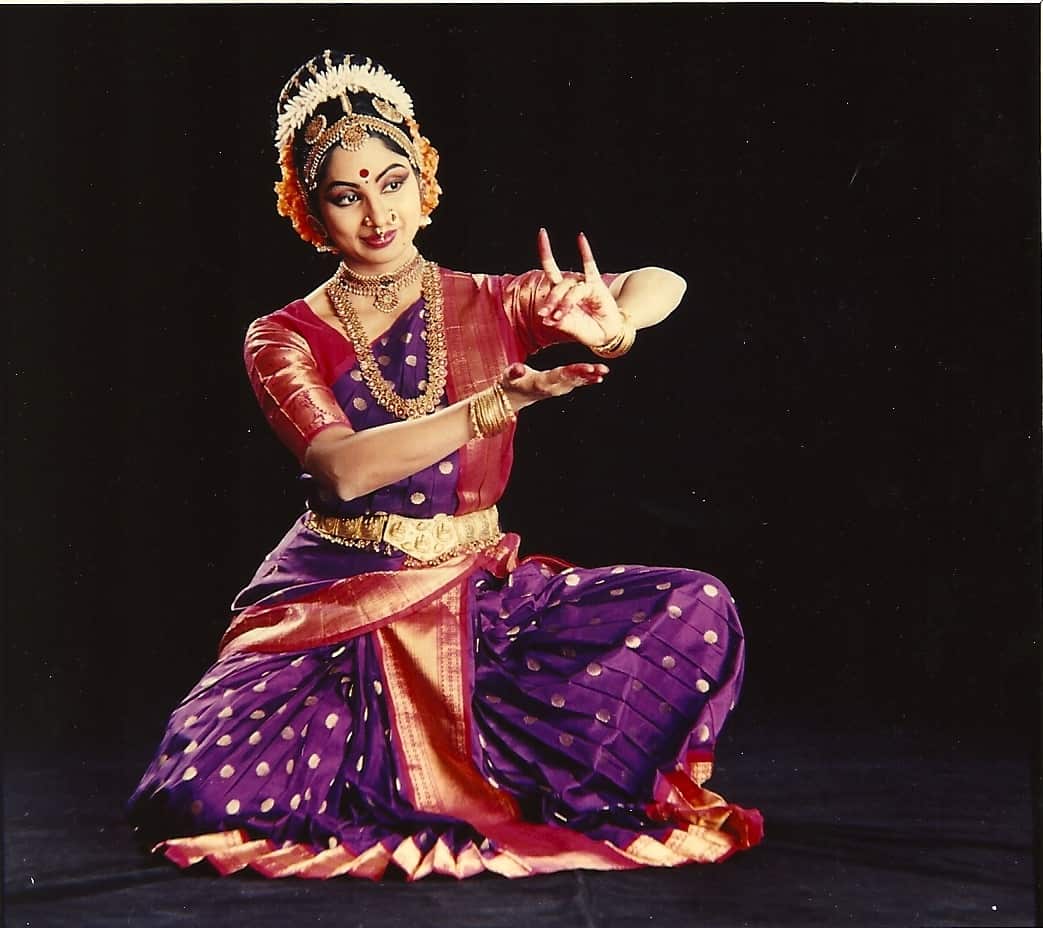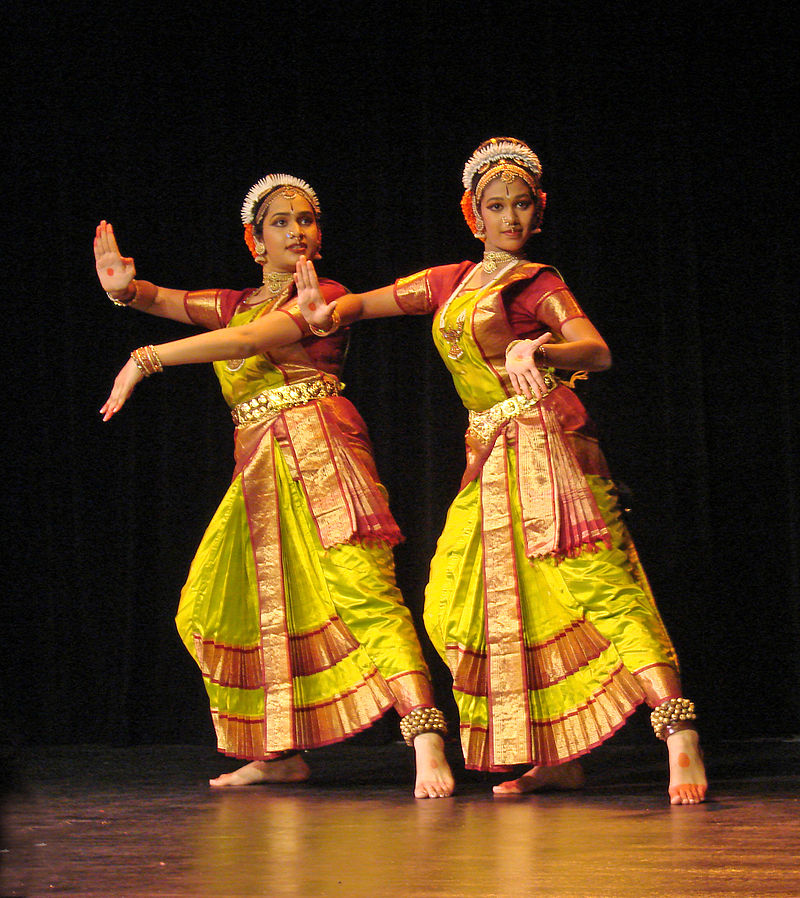Kuchipudi – Classical Dance From Andhra Pradesh

Kuchipudi is a form of South Indian classical dance whose name is derived from the Southeastern Indian village where it first developed. Kalanidhi means ‘Treasure Chest of Art‘.
The Kuchipudi performance usually begins with an invocation. Then, each costumed actor is introduced, their role stated, and who then performs a short dance prelim to music (dharavu). Next, the performance presents a pure dance (nritta). This is followed by an expressive part of the performance (nritya), where rhythmic gestures as a sign language mime the play.
Origin
It is believed that the tradition of Kuchipudi goes back over two thousand years, based on temple sculptures in the area. Kuchipudi is performed to South Indian Carnatic music performed on the mrudangam (two-headed drum), tambura (a stringed drone instrument), violin, and sometimes flute. It is one of the seven forms of South Indian Classical Dance.
There are two branches of the Kuchipudi dance tradition: the temple dance and the dance drama or street play. Young girls were given or married to the temple and trained in Kuchipudi as a form of active, performative prayer. The street play (or yakshagana) was performed by traveling troupes that went from village to village to spread Indian religious faith. The content of these plays was entirely based on gods, goddesses, legends, and epics of South Indian culture. By the fourteenth century, Kuchipudi traditions had begun to wane. At that time, Siddhendra Yogi (the so-called “Father of Kuchipudi”) began training young Brahman boys in the art of Kuchipudi and standardizing the form. While Kuchipudi’s expressive facial techniques and subtle body movements document and preserve the centuries-old body language of Andhra Pradesh women, Siddhendra Yogi’s choice of exclusively training boys (because it was easier to travel with a group of males) caused the tradition to pass from women to men for several centuries.
Both branches of the tradition — temple and yakshagana — were supported by patronage, a system that ended with the invasion of the British in the mid-nineteenth century. In the absence of patronage, dancers resorted to prostitution, generating a significant stigma around Kuchipudi, and the tradition went into a period of pronounced disarray until the end of British rule in the mid-twentieth century.
Suggested Read: Andhra Pradesh – Culture and Tradition
Kuchipudi Costume

A dancer in a male role would be in Angivastra, also known as Bagalbandi, wear a dhoti (a single pleated piece of cloth hanging down from the waist). A dancer in a female role would wear a Sari with light makeup. Modern Kuchipudi dancers retain the male dress but for females, they have made it more elaborated like Bharatanatyam Women artists wear a brilliantly colorful Sari (or a body fitting dress) with a pleated fan stitched in front to help highlight the exacting footwork.
The end of the wrapped Sari is held fast under a light metallic (golden or brass) belt at waist. A Kuchipudi artist braids her hair somewhat differently than a Bharatanatyam artist, to reflect the regional traditions, yet wearing flowers are common. Both have symbolic elements embedded in their hair and face jewelry, such as the Vedic symbolism for the sun and the moon, the soul, and nature, and she sometimes sets her hairdo in the Tribhuvan style which represents the three worlds.
Her jewelry may include hair jewelry, ear, nose, armlets, necklaces, and often a leather anklet piece with little bells (ghungroo). The forehead has a round red bindi or asymmetric tilaka, while the eyes are typically ringed with black collyrium to ease the viewing of expressions by the audience.
Suggested Read: Tirupati
Sequence
Kuchipudi show sequence always consists of nritta and nritya in solo or group performance, but when the underlying text is a play, it may include a Natya. The nritta or pure abstract dance parts of Kuchipudi, states Reginald Massey, may include parts such as darus, jatis, jatiswarams, tirmanas, and tillanas. The nritya or expressive performance in Kuchipudi includes padams, varnams, shabdams, and shlokas.
The conductor of the performance enters and plants an “Indra’s banner” staff, then introduces all the actors and the characters they play, who are revealed behind a curtain, and when each actor arrives, the colored resin is thrown into the flame of one or more torches for dramatic color effects and audience’s attention. Each actor performs a short dance called the Pravesa Daru accompanied by a short musical piece, as the vocalist describes his or her role.
After the actors have been introduced, the nritta part of the Kuchipudi performance starts. The actors present a pure dance (jatis or jatiswarams), performed rhythmically to a musical raga, and these are called Sollakath or Patakshara. A basic unit of dance in Kuchipudi is called an adugu (or adugulu), and these correspond to the karana in Natya Shastra. Each basic unit combines hand and foot movement into a harmonious sthana (posture) and chari (gait), that visually appeals to the audience wherever he or maybe sitting. Each dance unit, according to the ancient text, is best performed to the certain recitation of mnemonic syllables and musical beat. A series of karana form a jati, formalized originally as an oral tradition through Sanskrit mnemonics, later written, and these form the foundation of what is performed in nritta sequence of Kuchipudi.
After nritya comes the expressive part called abhinaya, and this is the heart of the play. The actor-dancer uses hand mudras and facial expressions inspired by the sign language in ancient Sanskrit texts, with exacting footwork, to communicate the underlying story to the audience. The play part is called Shabdam, a varnam combines dance with mime in order to draw out and express the rasa (emotional taste). Parts set to poetry that are love lyrics or express deeper sentiments are called a padam.
Kavutvams are a feature of the performance that is distinctive to Kuchipudi. These are performed either as nritta or nritya, to different talas, wherein the dancer adds acrobatics to the complexity of presentation. For example, the dancer may perform the footwork, rhythmically to music, while balancing a series of pots on his or her head, and then add burning Diya (lamp) in both hands, as the show goes on. Some artists dip their foot on a wet ink pad, then dance rhythmically on a blank white piece of paper, thus painting it; alternatively, the troupe places colored rice powder on the floor and on top of the white piece of paper, then dances the musical composition on it, their weight and steps causing the pigment to stick. At the end of the performance, the artist shows the audience the natural scenery or bird or flower or Ganesha or something that results. A Mayur Kavutvam dance produces a painting of a peacock, a Vinayaka Kavutvam of Ganesha, a Simhanandi Kavutvam yields the painting of a lion, each set to a certain classical composition and beat, for instance.
Suggested Read: Telugu Language
